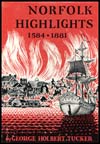Chapter 36
The 1855 Yellow Fever Epidemic
The 1855 yellow fever epidemic, referred to by contemporaries as "The Death Storm," that wiped out around two thousand of Norfolk's population, was one of the worst disasters in the history of the city.
Norfolk had previously experienced bad outbreaks of "Yellow Jack" -- notably in 1795, 1802, 1821, and 1826 -- but none of them could compare with the epidemic of 1855. Then, on June 7, 1855, the steamer Ben Franklin, en route to New York from St. Thomas in the Virgin Islands, where a yellow fever epidemic was raging, put into Hampton Roads in distress. Her hold, containing the larvae of the deadly yellow fever transmitting mosquito, the Aedes aegypti, was a vertiable Pandora's Box of pestilential evil.
The Ben Franklin was quarantined in Hampton Roads until June 19, when the health authorities permitted her captain to take her to Page and Allen's shipyard near the Gosport Navy Yard on the condition that her hold "was not to be broken up." After tying up at the shipyard, however, the captain violated his promise and had the hatches opened and the bilges pumped out.
The first man stricken was a Richmond machinist named Carter who was working in the ship's hold. On July 5, he came down with the fever, and three days later he died. His death was followed by an outbreak of the fever in a crowded nearby tenement known as "Irish Row," from which it spread into Portsmouth.
When "Irish Row" was closed by the health authorities, Norfolk gave shelter to some of the families that had been evicted from the slum and quartered them in an equally rundown tenement on South Church Street known as "Barry's Row." It was there that the fever broke out in Norfolk on July 30, after which it spread rapidly thoroughout the city.
At that point, a general exodus to escape from the dread disease began. But before long many cities, notably New York, Richmond, and Petersburg, which had at first welcomed the refugees, refused to receive any others from the pestilence-stricken Norfolk area. It is also a matter of record that a boatload of refugees was repulsed at bayonet-point while attempting to land at Old Point.
There were other communities, however, notably the Virginia Eastern Shore, Mathews County, and Fredericksburg, that gave asylum to those fleeing from the fever. And soon, moved by accounts of the pitiful plight of Norfolk that appeared in the nation's press, volunteers from all over the country came to Norfolk to nurse the stricken, while substantial sums of money were collected to assist the fever-racked community.
August 14 was set aside by the authorities as a day of humiliation and prayer, but the fever continued to rage. And before the end of August all business in Norfolk had been suspended and the city was one great hospital. The only vessel entering the Norfolk harbor at that time was the little steamer J.E. Coffee that met boats from Baltimore and Richmond in Hampton Roads to pick up the mail and bring in coffins. Before long, however, coffins became a luxury, and the bodies of the fever victims had to be buried in boxes or in the blankets in which they had died.
Many Norfolkians, because of their untiring efforts, became legendary heros during the epidemic, notably the Reverend Mathew O'Keefe, pastor of St. Patrick's Catholic Church, and Dr. George D. Armstrong, the Norfolk Presbyterian minister. Armstrong later wrote a fascinating account of his experiences, "A History of the Ravages of the Yellow Fever in Norfolk, Virginia, A.D. 1855," that describes the ninety-day terror in graphic detail. And although he had no idea that the wind-borne mosquito was the agent of transmission of the fever, he came close to pinpointing the cause when he observed: "The disease . . . spread rapidly in the direction of the prevailing winds and but slowly in the direction across the track of those winds."
Finally, with the coming of frost, the epidemic ended. Of those who survived, according to Burton's "History of Norfolk," "every man, woman and child, almost without exception had been stricken by the fell fever and about 2,000 had been buried."
Chapter
37
Two Memorable Freezes
Norfolk Highlights 1584 - 1881

See the "Table of Contents" for links to every chapter in Norfolk Highlights 1584 - 1881 by George Holbert Tucker.
